Freshmen have been excluded from these previews, as we'd like to wait and see what they have to offer on the NCAA circuit before we come to any long-term conclusions.
-Top 20 Prospects in the Big Ten
-Top 25 Prospects in the ACC
-Top 15 Prospects in the Big 12
-Top 15 Prospects in the Pac-12
-Top 25 Prospects in the Big East
-Top 15 NBA Prospects in the SEC
-Top NBA Draft Prospects in the Non-BCS Conferences, Part One (#1-5)
-Top NBA Draft Prospects in the Non-BCS Conferences, Part Two (#6-10)
-Top NBA Draft Prospects in the Non-BCS Conferences, Part Three (#11-15)
-Top NBA Draft Prospects in the Non-BCS Conferences, Part Four (#16-20)
-Top NBA Draft Prospects in the Non-BCS Conferences, Part Five (#21-25)
#26 Kyle Weems, 6-6, Senior, Small Forward, Missouri State
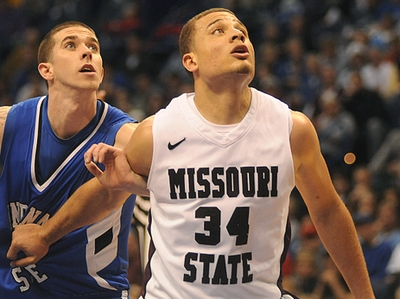
Jonathan Givony
The reigning Missouri Valley Conference player of the year, Kyle Weems enters his redshirt senior year after an interesting offseason. He had the opportunity to transfer this summer to a BCS school (Kansas, Kansas State, Oregon, Cal were all reportedly interested) and become eligible to play immediately since he already holds his bachelor's degree. Despite seeing his Head Coach, Cuonzo Martin, move on to Tennessee and be replaced by Purdue assistant Paul Lusk, Weems decided to remain loyal to Missouri State and come back for one last run at the NCAA tournament.
Weems saw most of his minutes at power forward for Missouri State last year despite the fact that he's only 6-6. He possesses a strong frame, but is not an overly athletic prospect, lacking the typical quickness and explosiveness you like to see from a player his size in the NBA. Weems was carrying an extra 5-10 pounds last season, but that's something he reportedly addressed this offseason with a stringent conditioning program.
What Weems lacks in style he makes up for with substance. A highly efficient scorer (53% 2P, 40% 3P, 79% FT), Weems displays many of the characteristics NBA scouts like to see in potential role-players.
Weems' most consistent means of scoring is based in his jump-shooting ability. 39% of his field goal attempts came from beyond the arc last season, of which he converted a solid 40%. He makes shots with both his feet set or off the dribble, displaying a quick release and a nice follow through. He's very effective generating offense in the mid-range area, using his body to create space and elevate smoothly for the pull-up jumper.
Weems is not a prolific driver at this stage, possessing neither the first step nor the advanced ball-handling skills to get into the paint and finish at a high rate. This lack of dribble-drive ability is the main reason he got to the free throw line just 4.3 times per-40 minutes pace adjusted last season. Most of his slashing opportunities come on straight line dribbles, where he can lower his shoulder and overpower opponents using his strength.
Weems finds ways to score in other ways, though, be it off post-ups (mostly consisting of turnaround jumpers), short isos, in transition, coming off screens and crashing the offensive glass. He is not very turnover pronecoughing the ball up on just 11% of his used possessionswhich is definitely a positive considering his future role.
He's also a very good rebounder for his size, pulling down nearly 10 boards per-40 minutes pace adjusted.
The biggest question marks regarding Weems' NBA prospects revolve around his play on the defensive end. He'll have to make the transition from guarding Missouri Valley Conference power forwards to NBA wing players, which could be difficult considering his average lateral quickness. Weems struggles at times already to stay in front of quicker players on the perimeter. His effort level isn't always where it needs to be, which is understandable considering his role, but is not something NBA scouts are going to want to see.
If Weems can find a way to shore up his defensive limitations and continues to work on his jump-shot, there could be a role for him in the NBA, possibly similar to the one Jared Dudley plays in Phoenix. Already 22 years old, he'll need to earn a roster spot through productivity and showing he can help a team win games, which he has a chance to start doing right now for a rebuilding Missouri State program.
#27 Alex Young, 6-6, Small Forward, Senior, IUPUI
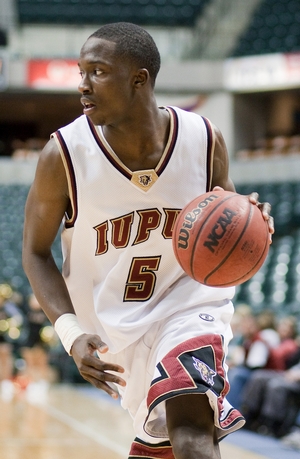
Joseph Treutlein
Steadily improving his production and playing an expanding role his first three seasons on campus, Alex Young has established himself as a very good scorer at the college level, and will look to capitalize on that as a senior.
Standing 6-6 with a well-built frame and good length, Alex Young is a good overall athlete with a knack for putting the ball in the basket, but still has room to develop his skills in a variety of areas.
On the offensive end, Young does most of his damage attacking the basket, mostly operating with the ball in his hands. His scoring attempts are about evenly split up between isolations, pick-and-rolls, and spot-up catch-and-drives, with him being comfortable in all three situations against the level of competition he faces.
As a ball-handler, the left-handed Young is very reliant on his dominant hand with both dribbling and finishing, often going left on drives to the basket, and usually finding a way to get back to his left hand on the occasions he goes right. Against the level of competition he faces, with his size and athletic abilities, this isn't very problematic, but obviously poses concerns projecting to higher levels. His ball-handling overall is not especially polished, as he doesn't utilize much in terms of advanced moves and his control is lacking at times, but he does a good job taking advantage of his physical tools and also utilizing subtle changes of direction to get around his man.
Young is definitely at his best on spot-up drives where he already has a half step on his man, showing solid instincts in this regard and doing a good job finding the quickest route to the basket, where he's a capable finisher and isn't afraid to draw contact. Young scores in a variety of ways at the rim, utilizing both lay-ups and an array of floaters and runners, but shows problems on the rare occasions his opponents have a formidable help-side defender in the lane, where Young can get very erratic with his finishing.
In isolations, Young isn't quite as comfortable, not always being able to take advantage of his physical tools, as despite his good first step, his average ball-handling skills don't always allow him to utilize it. Young's ability to pull up for jumpers off the dribble is also still a work in progress, as despite him relying on it often, he's very inefficient on these attempts, scoring 0.61 points per possession on pull-up shots according to Synergy.
As a spot-up jump shooter, Young shows potential and has excelled in prior seasons (39.6% three-point shooting on 5.1 attempts per game as a sophomore), but didn't really stand out in this area as a junior, shooting just 33.3% from three on 3.6 attempts per game. Young has solid form with a high and quick release along with flashes of deep range, but he can get sloppy at times and isn't consistent with keeping his legs under him. Really improving in this area would be very helpful to his stock, as spot-up three-point shooting is a highly coveted skill in the NBA among role-playing wings.
In terms of the rest of his offense, Young does a good job throwing his frame around to compete on put-backs around the rim and is also occasionally featured on cuts, two things that he'd likely be asked to do more of if he makes it in the NBA. It's tough to really get a feel for Young's ability on off-ball cuts given the role he plays, and that makes it somewhat difficult to project him to the next level, where he wouldn't be asked to play the go-to scorer role he plays for IUPUI.
On the defensive end, Young shows decent tools with his size and length, while also looking capable in terms of lateral quickness, but his commitment and fundamentals can be inconsistent. Young is prone to letting out of his stance early in isolations and not doing the best he can to contest shots both on the perimeter in the lane, not fully applying himself on this end like he does on offense. Really buckling down here should be a priority for Young this season, and will likely be very important for his stock.
Looking forward, Young appears to be an ideal candidate for the Portsmouth Invitational Tournament in April, and should get his share of due diligence looks from NBA teams throughout the year. Improving his perimeter shooting, ability to finish against help defense in the lane, and his overall defensive abilities and commitment would all be very helpful to his stock, as would a strong season for his team. The Jaguars have early season matchups against Georgetown and Louisville, and Young shouldn't miss out on those opportunities to catch the attention of scouts.
#28, D.J. Cooper, 5-11, Point Guard, Junior, Ohio
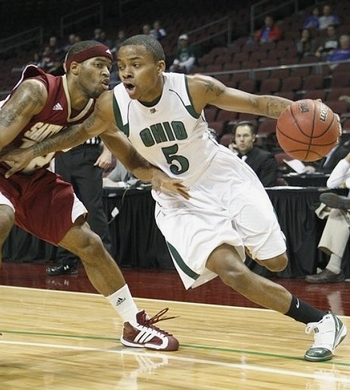
Walker Beeken
Chicago native D.J. Cooper came out of the gates quickly in his college career at Ohio, earning MAC Freshman of the Year honors in 2009-2010 and coming up big in the NCAA tournament in a first round upset over Georgetown. He continued his strong play last season, averaging 15.8 points, 7.5 assists, and 2.3 steals per game and earning a spot on the MAC all-conference team. The dynamic guard will look to expand on his production as a junior, while shoring up some of his weaknesses, in order to get himself on the radar of NBA scouts.
Standing at only 5'11 and 165 pounds, Cooper's small stature puts him at a disadvantage when evaluating his NBA prospects. He does, however, possess very good athleticism, with great speed, quickness, and explosiveness.
He's an absolute jet with the ball in his hands, and he has plenty of freedom to create, with the ability to get into the paint off the dribble regularly. He used an extremely high rate of his possessions (37%) as the pick and roll ball-handler last season, but was largely inefficient (.69 points per possession), struggling with decision-making, taking difficult shots off the dribble, and having trouble finishing at the rim.
This is the case with Cooper's game in general, as he's an excellent creator, thanks to his quick burst and great change of speed and direction dribbles, but he has trouble at this stage reigning himself in and picking his spots.
This is evident when looking at his shooting numbers. Cooper, a lefty, has a decent stroke, as shown by the fact that he made a solid 76% of his free throws and 35% of his catch-and-shoot jumpers last season. His efficiency dropped dramatically off the dribble, however, connecting on an extremely poor 15% of his pull-up jumpers. He does a nice job of creating space to get his shot off, but he'll need to make big strides with his shot selection to become more efficient.
When attacking the basket, Cooper has a scorer's mentality but also has very good passing instincts, as shown by his 8 assists per-40 pace adjusted last season, ranking him third in the country. As a finisher, he's ultimately limited due to his lack of size, but he's very creative and able to make some difficult shots, including a nice tear drop floater, which he uses regularly.
Defensively, Cooper plays hard and is very quick laterally, but his size will always be a concern with bigger guards being able to shoot over the top of him and outmuscle him on dribble penetration. He does a good job utilizing his quick hands and good instincts to create turnovers, but he tends to gamble a bit too often and needs to focus on better positioning.
Overall, Cooper is a prospect worth keeping an eye on as his excellent speed and creativity off the bounce are coveted traits in today's NBA. His size is always going to be an obstacle, though, and the niche for players of his mold is a small one. In order to get the attention of more NBA scouts over his final two college seasons, Cooper will need to make some big improvements with his shot selection and learn how to better pick his spots to highlight his talents while becoming more efficient.
#29 Brandon Davies, 6'9, Junior, Power Forward, BYU
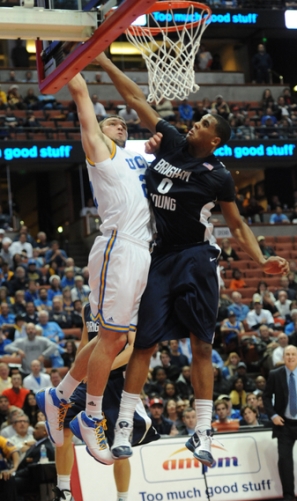
Jeff Rush
Last year was magical in Provo as the nation caught Jimmer-mania and the Cougars had one of the best years in the proud history of the program. The only real negative during the season was the suspension of Brandon Davies in late February, which left BYU extremely thin in the front court heading into post-season play. Davies reportedly impregnated a woman, a violation of the Mormon school's honor code which says students must remain chaste and virtuous.
BYU regrouped and advanced to the Sweet 16 despite his absence, but there they ran into the powerful Florida frontcourt and lost in overtime. For 2011-2012, Davies is back and will be counted on to be the Cougars' best player and keep them in among the top mid-major programs in the country.
Physically, Davies has some interesting tools. He is a legit 6'9 with very long arms and can cause a lot of problems for opposing defenses running the floor in transition. He is listed at 235 pounds, but he is not nearly strong enough to be effective banging in the lane as he often gets knocked off balance while making his move in the paint. Another strike against Davies athletically is the fact that he is not explosive when jumping off of two feet, which limits his ability to finish over other post players in the lane. He is capable of making a move off the dribble and dunking on someone, but only if he gets a running start and jumps off of one foot.
In the post, Davies puts the ball on the floor just about every time he makes a move regardless of whether he is going over his left or right shoulder. He is most effective making sweeping moves across the lane going either direction and using his length to finish around his defender. This is something that he is able to get away with because of the shooters that BYU has all over the floor, which allows him to work one-on-one in the post with a lot of open space. He struggles in these situations when the lane is crowded which often leads to him forcing awkward shots in the lane. He is easily bumped off balance and he tends to force shots while falling away when he is bodied by a defender.
On the perimeter Davies' game is almost non-existent. While he did make major strides at the free throw line, improving by 11% in almost double the amount of attempts per-game from his freshman year. Away from the charity stripe, Davies' struggled mightily taking jump shots from the perimeter, shooting only 24%. He was willing to shoot jumpers out to 15-17', but rarely did a defender venture that far from the basket to guard him, preferring to clog up the middle and concede the jump shot.
Davies did do a good job of protecting the ball, sporting a 1/1 a/to ratio although he is not a guy that will be asked to create shots for others. This season he will be the focal point of the Cougar's offense and will be counted on to make plays as the primary post weapon.
On the defensive end of the floor, Davies is a solid but unspectacular defender. He does not do a very good job of fighting for position or denying the entry pass, however he does do a good job of playing big with high hands to cause problems with his length. He seems to be actively avoiding any type of fouls, which could be by design to keep him on the floor because of a severe lack of depth in the post for BYU. Davies was pretty effective while in isolation situations, often brought on by switches in the pick and roll, as he does a good job by using his length to make up for his lack of quickness.
After riding excellent guard play to the Sweet 16 last year, Brigham Young will have to completely change the way their offense runs in their first post-Jimmer season. Davies will be a focal point offensively and it will be imperative for him to have made major strides in his game from his sophomore year. In order to reach his full potential and play at the next level Davies will need to expand his offense and continue to work on his body.
#30, Keith Wright, 6'8, Senior,PF, Harvard
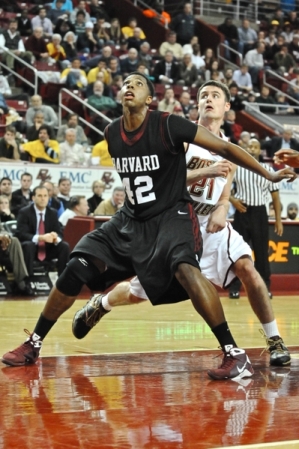
Derek Bodner
Keith Wright returns for his senior year at Harvard after a junior season that saw him capture the Ivy League player of the year award, while his team earned their most wins in school history. The Crimson fell a basket short of the Ivy League championship and their first NCAA tournament appearance in over 60 years.
Harvard returns all of their major contributors from that 23 win team, none more important than Keith Wright. The 6'8 big man improved his contributions across the board, increasing his minutes (32.3 minutes per game, up from 21.4), scoring output (19.1 points per 40 minutes, pace adjusted, from 16.2), rebounding (10.7, from 8.3), and efficiency (61% true shooting percentage, up from 57%), taking the leadership role on a young Crimson team from the departed Jeremy Lin.
Wright would be undersized for the power forward spot at the next level at 6'8, but has solid length and wide shoulders, although he could stand to improve his frame a little bit more. Not a leaper by NBA standards, Wright operates primarily under the basket, an athletic limitation that may be tough to overcome.
Wright gets the majority of his offense in the post, where he is quicker and stronger than most of his defenders and has solid footwork. He does a good job of sealing his defender and creating room for an entry pass, and he has a quick spinning hook over either shoulder as well as a strong drop step that he converts with efficiency. His touch around the hoop is only average, he doesn't get to the line at an exceptional rate, and he appears to be bothered by length, something that puts into question how well, if at all, this staple of his game would translate to the next level.
The majority of the rest of his offense comes off of cuts to the basket and offensive rebounds. His 4.1 offensive rebounds per 40 minutes pace adjusted are in the top half of our database for power forward prospects, and he converts these at an excellent clip, in the top percentile according to Synergy Sports Technology. He does a good job of gathering himself quickly, keeping the ball high, and going up before the defense has re-set itself.
Wright's ability as a jump shooter is perhaps the most unknown part of his game, and a crucial area he has to prove if he wants to stick to a roster at the next level. Wright attempted very few jump shots last year for the Crimson, certainly not enough of a sample size to prove consistency. But on the rare occasions he did, he appeared to have consistent form and good results out to mid-range, something strengthened by his free throw percentage, which is at 72% through his first three years.
While Wright doesn't show great quickness or ball-handling skills, and doesn't appear to be poised to become a face-up threat at the next level even with an established threat as a jump shooter, it would allow him to transition to being a role player, as his post-game has questions on how well it would translate.
Defensively, Wright appears to give solid effort, and his length allows him to be effective as a weak side help defender. He has some physical limitations on this end of the court, as he isn't all that quick laterally, something that is sure to become more of an issue at the next level. He also isn't all that explosive off his feet, and it's questionable whether he would be the shot blocking threat he currently is. He also appears at times to get lost off the ball, particularly on over rotations, and is slow to recover.
On the defensive glass, his 6.6 defensive rebounds per 40 minutes is a fairly pedestrian number, especially for a guy who at most times was the tallest guy on the floor for his team. This can in part be explained by his role as a weak side help defender, but too often he was out of position when the shot went in the air, without the athleticism to get back and recover.
With the Crimson returning their core personnel from a 23 win team, led by senior forward Keith Wright, along with the continued improvement coach Tommy Amaker has shown since taking over the club in 2008, and a relatively weak schedule, they have a great chance to win the Ivy League and return to the NCAA tournament for the first time since the Truman administration. A little more exposure against legitimate competition, with continued expansion of his game as a jump shooter, may be enough to see Wright get a more extended look during the pre-draft process, or perhaps an invite to summer league and/or training camp.



































Comments